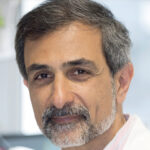About
The paired/ homeodomain genes Pax3 and Pax7, act primarily in somites to regulate stem/progenitor cells in the body whereas Tbx1 and Pitx2 play critical roles in cranial mesoderm derived muscles in the head. Subsequently, myogenic determination genes Myf5, Myod and Mrf4 regulate skeletal muscle progenitor cell fates. Using an extensive number of mouse mutants, we established epistatic relationships between these key regulators, and defined distinct cell states during myogenic lineage progression (1). We have shown that complementary pathways, governed by Pax3 in body, and Tbx1, in pharyngeal muscles, activate the core myogenic cell fate genes for initiating myogenesis (2). These findings show that the myogenic programme is modular – with founder stem cells born in different regions having distinct genetic signatures. It is intriguing that several muscle related pathologies are restricted to specific regions in the body, perhaps reflecting in part the ontological transcriptional programme that led to their establishment. We are pursing these genetic studies to assess somite versus cranial mesoderm derived skeletal muscles in development and during ontology of the structures using a number of approaches including cell lineage analysis, genetic mutants, and cell ablation strategies in the mouse.

